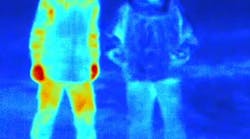By John McHale
PALO ALTO, Calif. — Engineers at Space Systems/Loral in Palo Alto, Calif., recently saved time and money on a payload test system (PTS) by outsourcing it to Agilent Technologies also of Palo Alto, Calif., instead of building and designing one in house.
"Among the reasons that we selected Agilent was the fact that our challenges posed no obstacles to them," says Duncan Blanks, deputy director of Spacecraft Engineering Test Operation at Space Systems/Loral.
"They have been in the RF business for many years, they've worked closely with us, and they understand our business, so overcoming these challenges was for them very easy. Any other company that hadn't had the exposure to this business would have found it much more difficult," Blanks says.
Space Systems/Loral experts had been building their own test systems, but the test equipment was not meeting their needs by providing them with informative test results in a reasonable time, Agilent officials explain. RF testing of the payload transponder was considered "the long pole in the tent" and was scrutinized for improvement.
Ultimately, Space Systems/Loral officials decided that the company's core competence was building spacecraft, not test equipment, and sought Agilent's help with its next generation PTS.
The system provided to Space Systems/ Loral, the Agilent 85121A PTS, consisted primarily of Agilent's own commercial off-the-shelf (COTS) equipment. Using COTS equipment results in a system with high reliability, high mean time between failures, and low mean time to repair.
A spacecraft will typically contain 48 transponders or repeaters, although this number is set to increase in future configurations, Agilent officials explain. These are effectively "mirrors in the sky," each receiving a signal at a certain frequency, down-converting it, filtering, amplifying and then rebroadcasting it over the satellite's footprint.
The route that a signal takes through the satellite is the pathway being tested by the PTS. There are about 160 paths, and for each path a suite of perhaps six different tests must be performed, they say.
Customization was accomplished primarily in the software and test algorithms were designed with HP VEE (Visual Engineering Environment) software, a graphical test development tool. HP VEE instrument drivers provide system interfacing between the test instruments and the measurement software.
One of the problems Space Systems/Loral asked Agilent experts to address was test system calibration. Space Systems/Loral engineers had been employing vector analysis in their calibration procedure but there was a faster alternative using scalar analysis, which looked at only power levels and eliminated phase and vector considerations, Agilent officials say.
Agilent designers applied the scalar technique, employing only RF power meters, and simplified the process to the point where a skilled technician can now perform the calibration procedure, they claim.
The Agilent system also improved the time necessary for a pathway test from 3.5 to 4 minutes to just 2.5 minutes, Agilent officials say. The device also enables simultaneous remote control of as many as five systems to improve speed, they add.
Space Systems/Loral has purchased a total of six PTSs from Agilent, operating in the 2 to 18.5 GHz range. New requirements call for UHF at approximately 200 MHz, with carriers in the 30 GHz range. Space Systems/Loral and Agilent officials are addressing the issues of these new requirements while ensuring the test systems will be backward compatible with previous systems, Agilent officials say.
Space Systems/Loral has ordered two more systems and is retrofitting two older systems, with the result that they will eventually have four Ku band and four Ka band systems for a total of eight.
Space Systems/Loral and Agilent engineers are also working on the next version, which will be designed to meet the next level of complexity in satellites, Agilent officials say. The next generation of satellites has on-board processors, primarily to provide direct Internet connections for high-usage customers. Signals will be digitized on the spacecraft, then re-upconverted and downlinked to the user.
The new approach will increase data speed, throughput, and switching speeds at a baseband frequency. This will enable experts to tune the satellite specifically to the needs of the customer, Agilent officials explain. It will respond to customers who are asking for high data rates or broad bandwidth by actually changing its personality to give the user a massive amount of capability.
On-board processors will also be used to fine-tune antennas, enabling Space Systems/Loral satellites to focus and shape the beam to radiate directly to the users who are paying for the service, they add.
For more information on test systems from Agilent Technologies contact the company by phone at 650-752-5000, by mail at Agilent Technologies 395 Page Mill Road, P.O. Box 10395, Palo Alto, Calif. 94303, or on the World Wide Web at http://www.agilent.com



